Best Dumbbell Leg Workout for Lower-Body Strength
Name your favorite day in the gym. If your gut reaction is Monday’s chest and back workout or Thursday’s shoulder exercises, here’s some bad news: You’re missing half your entire body and, odds are, it shows.
Just like movie reboots, leg day is revered by some and conspicuously avoided by others. Whichever side of the fence you fall on, it’s time to knock down at least one excuse for skipping any more dumbbell leg workouts.
Whether you’re trying to make the best of a barebones hotel gym, getting the most out of your home gym setup (word to the wise, invest in adjustable dumbbells), or just need a change of pace in a commercial facility, here are the best exercises to plug into a dumbbell-only leg workout.
How to Hold Dumbbells During a Leg Workout
When it’s time to perform a dumbbell workout on leg day, the versatility of dumbbell positioning can influence total-body muscle recruitment. While individual exercises will have their own textbook form, you can often adjust the dumbbell position to slightly change when and where stress is being applied.
This can lead to more muscles being involved in a given lift without necessarily reducing the work done by your legs. Working more muscle in one shot can generally lead to better overall results in the long term.
The standard position for many dumbbell leg exercises is to hold the weights with straight arms, hanging at your sides. Handling very heavy weights in this way could eventually tax your grip, so consider using lifting straps to prevent grip strength from being a limiting factor.
Another useful placement is a modified “rack position” (when a barbell is held across the fronts of your shoulders). Here, you’ll be holding the dumbbells near your shoulders with both arms bent. It should look similar to the top position of a hammer curl, with your palms facing each other, the thumb-side of the weights resting on or near the fronts of each shoulder, and your elbows pointed mostly forward.
Another position, which is often the most advanced option, is supporting the dumbbells overhead with your arms locked straight. This unconventional position requires (and builds) significant strength, mobility, and stability in your shoulders and upper back while still actively working your lower body.
Related: How to Do the Clean Exercise, Olympic Weightlifters’ Go-To for Explosive Power
10 Best Dumbbell Leg Exercises
1. Dumbbell Squat

Beth Bischoff
Why It Works
The dumbbell squat may be the most straightforward lower-body exercise around. It could technically be considered a “dumbbell deadlift,” instead of a squat, since the general movement is extremely similar to a barbell deadlift. However, simple adjustments in your upper-body position can shift the muscular focus to your quadriceps more than your glutes and hamstrings. As one of the most fundamental compound exercises, the dumbbell squat can be the star of any dumbbell leg workout. Whether you’re looking to build sculpted legs or improve lower-body strength and power, the dumbbell squat can help.
How to Do It
- Grab a pair of dumbbells off a flat bench or take them directly from the dumbbell rack.
- Hold the weights at your sides with your palms facing in toward your legs, to start.
- Set your feet roughly shoulder-width and descend, keeping your feet flat on the ground and your shoulders pulled back.
- Keep your hands facing in with the dumbbells at your sides throughout the rep. Don’t rotate or swing the weights forward.
- In the bottom position, your hands should be nearly in line with your mid-foot, not far in front of your toes.
- When you reach a comfortable depth, return to a standing position.
- To emphasize the fronts of your thighs (quadriceps), keep your upper body more vertical and upright rather than angled forward, which can recruit more glute muscle.
Sets and Reps
For muscle gains, use a weight that challenges you in the 8- to 12-rep range for 3 sets. To build strength, load up the dumbbell for 4 to 6 hard and heavy reps and work through 4 tough sets.
2. Goblet Squat
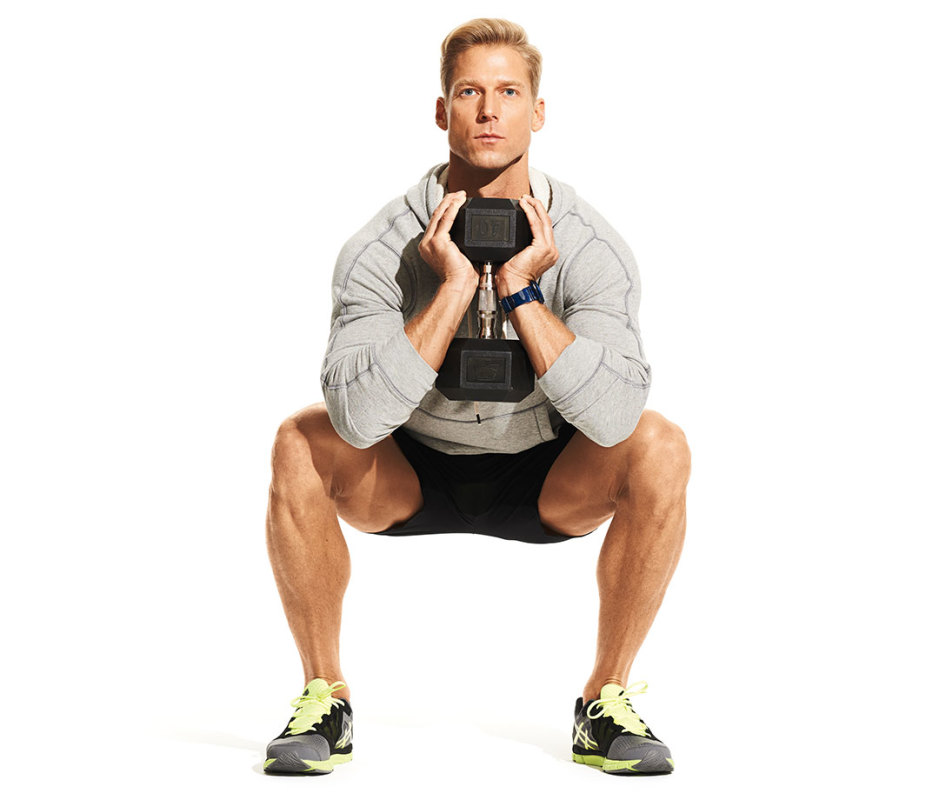
James Michelfelder
Why It Works
The goblet squat has gained popularity in recent years as a way to assess strength and mobility while improving lower-body development. Its key defining feature is the unique position of the weight—supporting a single dumbbell with both hands in front of your chest. This front-loaded posture builds core and upper back strength while also reducing lower back strain.
How to Do It
- Set a dumbbell vertically on one end between your feet.
- Clean the dumbbell to your collarbone by squatting down, placing fingers under the top weight plate, and exploding through legs to bring the dumbbell under your chin, catching the weight plate with your palms as if holding a goblet.
- Keep your shoulders pulled back, spine neutral, and elbows pointing out as you descend into a squat.
- Be careful not to straighten your arms or let the dumbbell drift too far forward.
Pro Tip
Because the supportive muscles of your upper back can become a limiting factor, the goblet squat is well-suited to moderate rep ranges.
Sets and Reps
Perform 3 to 4 sets of 8 to 15 reps to make the most of this staple exercise.
3. Rack Squat
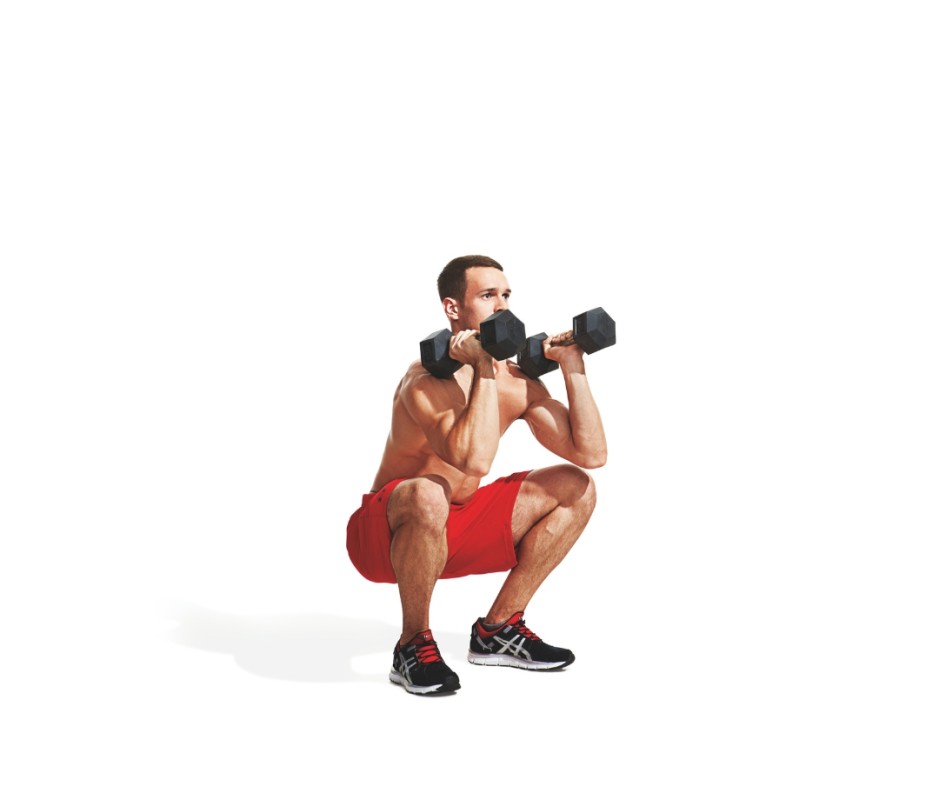
Beth Bischoff
This is the dumbbell’s answer to a classic barbell front squat. The rack squat may also be familiar to kettlebell enthusiasts, but the dumbbell version is equally effective for targeting the lower body.
How to Do It
- Hammer curl dumbbells into the top position, with the thumb-side of the weights near or on the front of your shoulders.
- Set your feet slightly wider than shoulder width.
- Brace your core as you squat to a comfortable depth.
- Push through your feet to rise.
Pro Tip
Sneak in some extra core training by doing a single-arm variation. Keep your non-working arm tight and “activated,” as if you’re holding an invisible dumbbell down at your hip. Keep your core engaged to prevent the offset load from pulling your upper body sideways, and avoid twisting toward or away from the weight. The single-arm rack squat recruits your abs, obliques, and even your lower back for stability. This makes it an efficient exercise for time-strapped lifters.
Sets and Reps
Perform 4 sets of 6 to 10 reps. If you do the single-arm variation, alternate arms on each set. Complete 1 set with the dumbbell in your right arm, rest a minute or so, then do the next set with the weight in your left arm, rest again, etc.
4. Single-Arm Overhead Squat
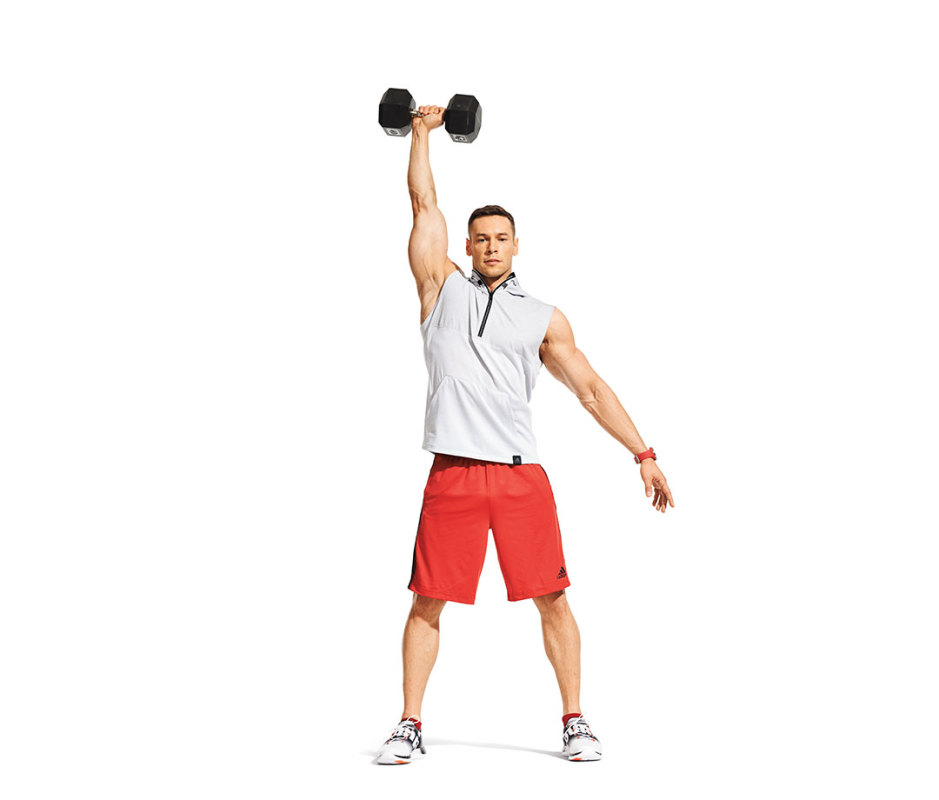
James Michelfelder
Why It Works
Arguably more of a general mobility drill than a dedicated leg-builder, the single-arm overhead squat can humble even the most advanced lifters. If you have trouble finding time to schedule dedicated workouts for stretching and mobility, consider this a fair compromise.
How to Do It
- Press a light dumbbell overhead, to start.
- With the weight locked in position, take a relatively wide stance.
- Descend as low as possible, but be aware that your body will be “distracted” by keeping the weight overhead, so your depth likely won’t be as low as a more traditional squat.
Pro Tip
The single-arm overhead squat should be the first exercise done in a workout because it requires the most attention and any pre-existing fatigue will drastically affect your performance. You can even add it into your general warmup to prepare your whole body for any intense session. Your upper body may self-correct and twist slightly during the squat due to various tight muscles. Aim to keep your shoulders as squared off as possible with minimum leaning. Keep your eyes on the weight throughout the entire movement. This should help focus, stability, and safety. If the weight swings or wobbles, end the set quickly. Dropping a dumbbell on your head is always bad for gains.
Sets and Reps
Perform 2 or 3 sets of 1 to 3 reps per arm.
Related: The Best Bodyweight Chest Exercises
5. Reverse Lunge
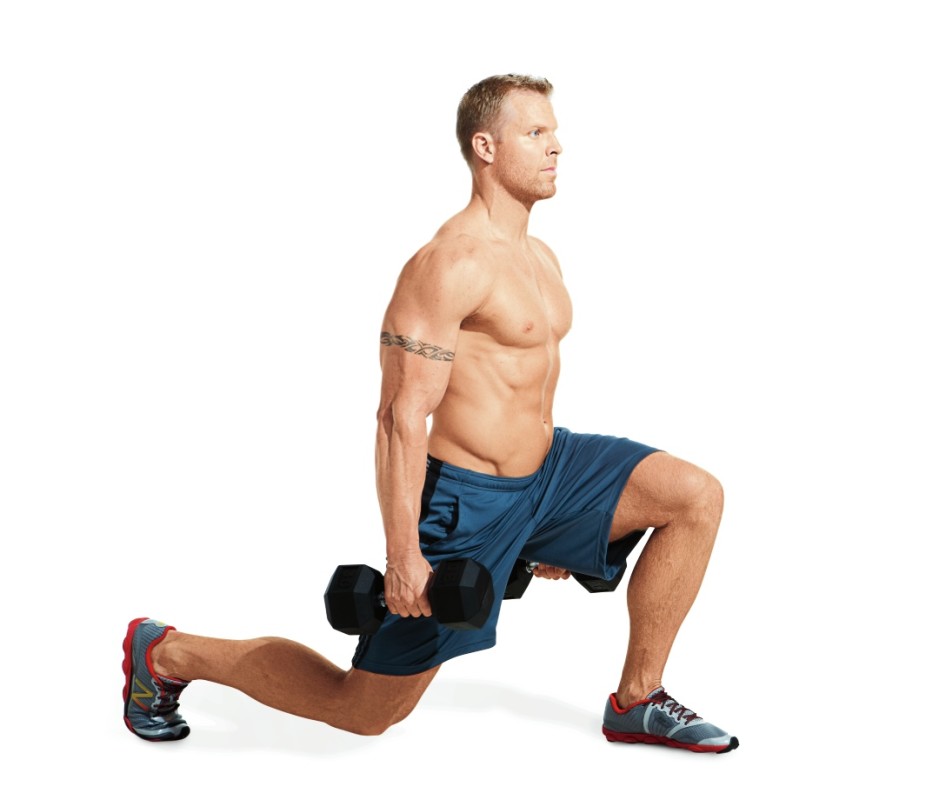
Beth Bishoff
Why It Works
The reverse lunge is a time-tested way to train your legs unilaterally, or one at a time. The backward-stepping motion helps to keep your front leg upright, which may reduce knee stress. This makes it an ideal choice for anyone dealing with aches and pains or general mobility issues.
How to Do It
- Stand upright with a dumbbell in each hand near your hips, to start.
- Take a large step back with one leg and plant the ball of your foot firmly on the ground. Keep your torso upright and your shoulder blades pinched together.
- Bend your front leg until the knee of your rear leg grazes the ground, if possible.
- Think about “squatting up and down” more than “gliding forward and back.”
- Drive up and straighten your front leg before “pulling” the back leg into the starting position.
Pro Tip
Use the reverse lunge during any portion of your workout. It’s normal to have one leg slightly stronger than the other. When possible, cater the weight and reps per set to your weaker leg, giving it a chance to “catch up” to the more developed side, even if it makes sets with your stronger side seem easier.
Sets and Reps
Complete all reps with one leg before switching sides. Do 3 sets of 10 to 12 reps per leg.
6. Skater Squat
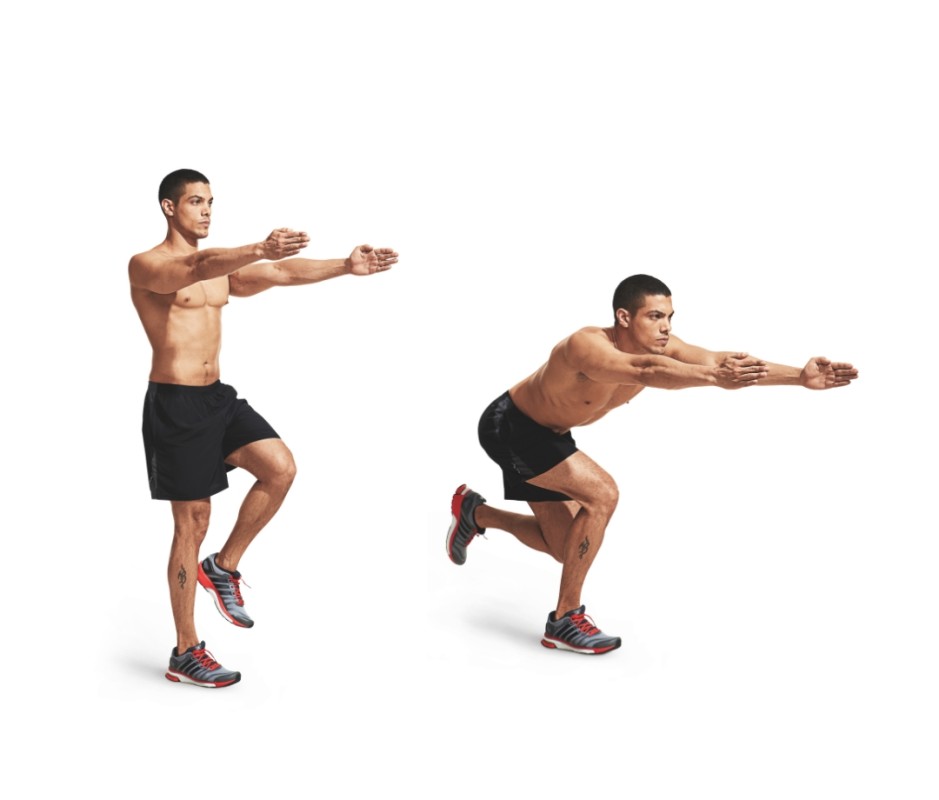
Beth Bischoff
Why It Works
This single-leg squat variation can be relatively advanced, since you’re supporting your bodyweight on one leg, so get familiar with the unloaded movement before adding dumbbells. However, the learning curve can be pretty quick and it can be an excellent addition to your dumbbell-only leg workout since it does address each leg on its own, which helps to address the natural strength and developmental discrepancies that affect almost everyone.
How to Do It
- Stand with or without dumbbells in each hand, to start.
- Slightly shift your body weight onto the working leg and bend the non-working leg off the ground.
- Lower your body into a squat while you reach your arms forward.
- Your arms should help total-body stability by acting as a counterbalance.
- In the bottom position, think about getting the shin—not the knee or toes—of your non-working leg on the ground, even if your strength and mobility don’t yet allow you to get into a very deep position.
- If your upper body stays more vertical, you’ll emphasize work done by your quadriceps.
- If you allow your upper body to lean forward (without rounding your back), your glutes become the key player.
- Use this subtle technique adjustment to suit your actual goal.
Pro Tip
The skater squat can be plugged into a leg workout at any point, either as one of the first exercises of the day or toward the end to polish off each leg on its own.
Sets and Reps
Perform 2 or 3 sets of 8 to 10 reps per leg.
7. Walking Lunge
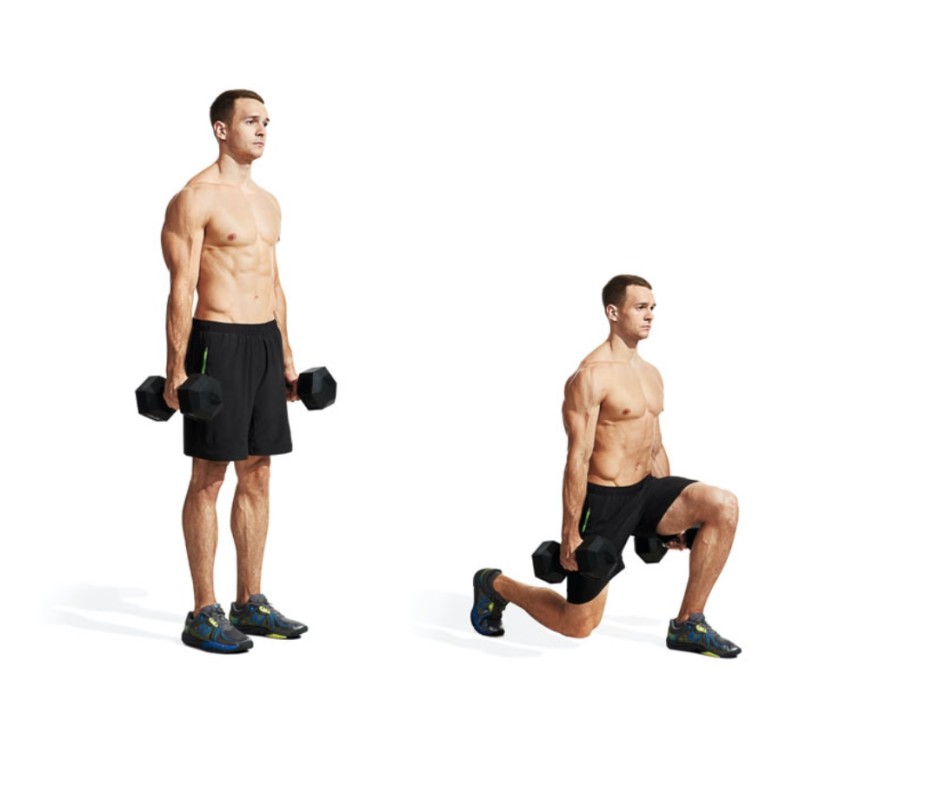
Beth Bischoff
Why It Works
The walking lunge may be a familiar sight to anyone who’s endured thorough leg training. This single-leg alternative takes it up to another level. By stepping forward with the same leg, your working muscles don’t get any respite from the burn, but your lungs still get the full cardiovascular hit of high-rep training.
How to Do It
- Start by standing with a pair of dumbbells at your sides.
- Take a moderate- to wide-step forward with one leg and plant your entire foot on the ground.
- Keep your upper body vertical and descend until your back leg nearly touches the ground.
- Straighten your leg and draw your back leg to the front, returning upright. Immediately step forward with the same leg and repeat.
- Instead of alternating legs with each rep, complete all reps with one leg before switching sides.
Pro Tip
The single-leg walking lunge should be done as the last exercise of the day, as a high-intensity finisher. The walking lunge is often performed with nonstop repetitions for 100 feet or one minute, but take a more conventional approach with this single-leg variation.
Sets and Reps
Do 2 sets of 10 to 15 reps per leg; it’ll seem like a muscle-burning eternity.
8. Split-Stance Dumbbell RDL
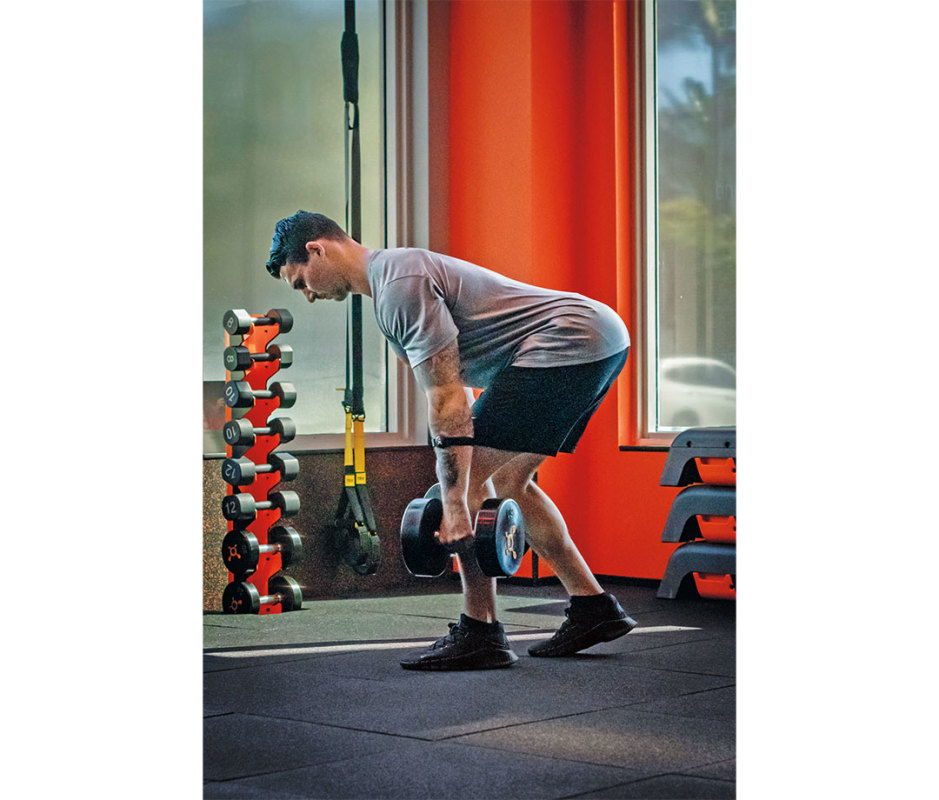
Jessica Chin Fong
Why It Works
Sometimes called a “B-stance” (for reasons nobody seems to actually know), this unique foot position delivers the muscular focus of a true single-leg movement without the balance and coordination requirements that would come from elevating your non-working leg fully into the air.
How to Do It
- Hold a pair of dumbbells at your sides and take a slightly staggered stance, with the toes of one foot planted in line with the heel of the foot of your working leg.
- Slightly bend your front leg.
- Keep your back neutral, not rounded, and slowly drive your tailbone back as you let the weights slide down the sides of your legs.
- You should feel steadily increasing tension as the glutes and hamstrings of your working leg are recruited into the stretch.
- When you’ve reached a comfortable depth, pause briefly before squeezing your glutes to return upright.
Pro Tip
The split-stance dumbbell Romanian deadlift takes some concentration and focus, so keep it close to the beginning of any leg workout. If your flexibility isn’t there yet, perform a split-stance deadlift with more of a bend in both legs (shown).
Sets and Reps
Perform all reps on one leg before switching your stance. Do 3 sets of 6 to 10 reps.
9. Pendlay Death March
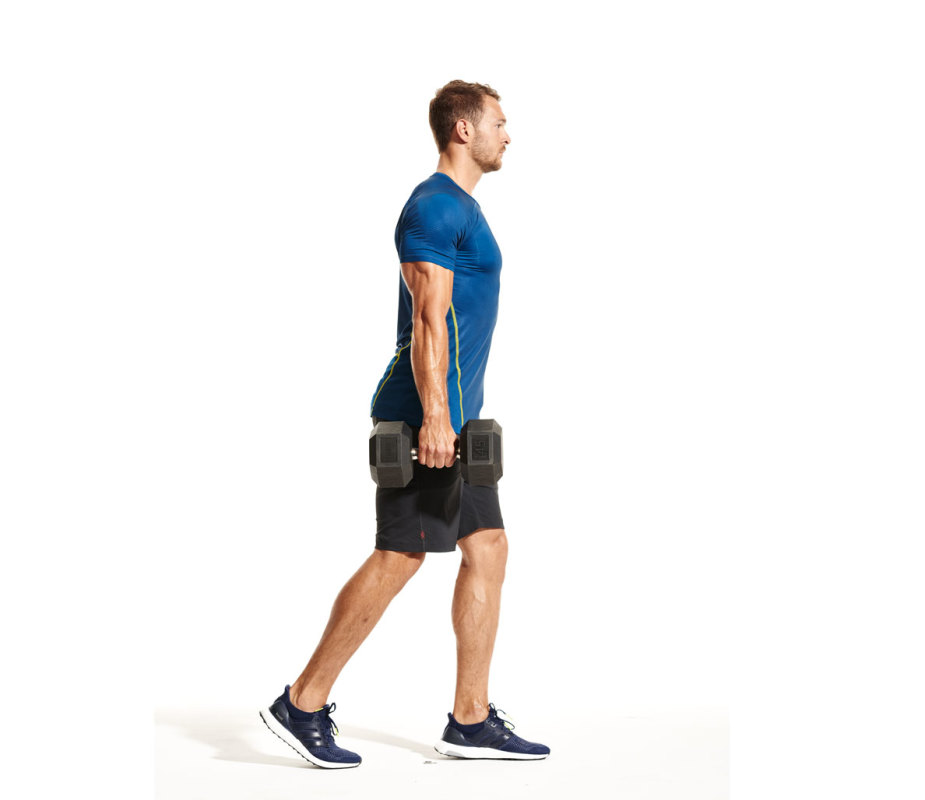
James Michelfelder
Why It Works
This intimidatingly named exercise was popularized, if not outright created by, Olympic weightlifting coach Glenn Pendlay (who’s also well-known for popularizing the back-building Pendlay row). The death march is essentially a walking lunge/Romanian deadlift hybrid, merging the best from both exercises into one painfully effective monstrosity.
How to Do It
- Start standing with dumbbells at your sides.
- Take a short step forward with one leg, slightly bend both legs, and drive your hips back.
- Lower the weights toward the ground, keeping your back neutral (not rounded).
- When you feel a strong stretch in the front leg, drive your hips forward to return upright and step through with your back leg.
- Repeat the backward hip drive and descent with the opposite leg now in front.
- Continue alternating legs as you travel forward.
Pro Tip
The Pendlay death march is so intense and comprehensive it could nearly be a standalone workout.
Sets and Reps
Like the walking lunge, it can be programmed either for distance (3 or 4 sets of 50 to 100 feet), for time (3 sets of 1-minute rounds using nonstop repetitions), or more simply for 3 or 4 sets of 15 to 20 reps per leg).
10. Single-Arm Dumbbell Swing
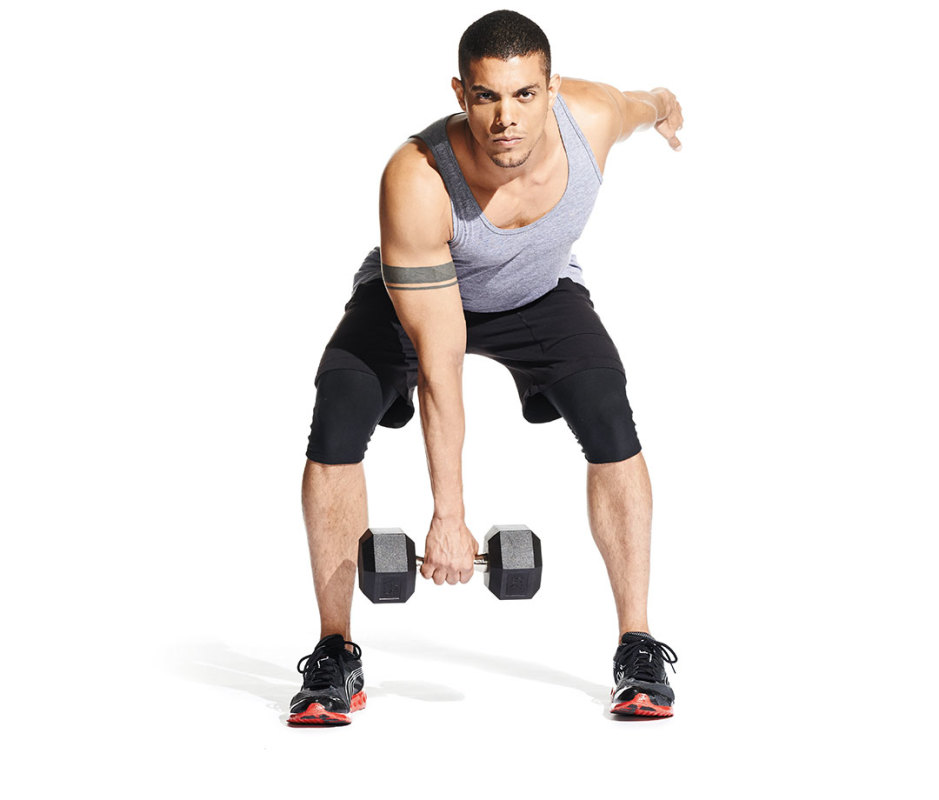
Jorg Badura
Why It Works
While swings are most often associated with kettlebells, you can actually get all of the same muscular and cardiovascular benefits when using a dumbbell. The single-arm dumbbell swing offers more core activation than the standard two-arm swing.
How to Do It
- Take a wide stance with a dumbbell in one hand at your side.
- Slightly bend your legs and allow the weight to, you guessed it, swing back between your knees.
- Don’t allow your back to round, and fight the load’s attempt to twist your upper body.
- Reach your tailbone backward before explosively driving forward to propel the dumbbell up, keeping your arm straight.
- Don’t squat up and down, and don’t actively lift with your arm—a powerful hip drive should create the movement.
- When the dumbbell approaches chest or abdomen height, let it “free fall” slightly behind your knees before smoothly transitioning into the next rep.
Pro Tip
Some like to keep the dumbbell in a “thumbs up” position, rather than a “palm down” orientation. This will help to keep your shoulder and upper back in a safe and powerful posture.
Sets and Reps
Do all reps on one arm, then switch for the next set. Try an “every minute on the minute,” or EMOM, workout. Set a timer for 12 to 15 minutes. At the top of each minute, complete 10 to 25 reps and rest for the remainder of that minute (ideally 30 seconds or so). Since it’s a single-arm exercise, alternate arms with each minute: Minute one, left arm; minute two, right arm; minute three, left arm; etc.
Related: These 10 Compound Exercises Save Time in the Gym Without Sacrificing Gains
Benefits of Dumbbell Leg Workouts
A leg day dumbbell workout can deliver most, if not all, of the benefits of a workout that incorporates barbells and machines. True, you won’t build a 405 pound squat training exclusively with dumbbells, but you can still build serious lower body strength and muscular size. Ultimately, your body doesn’t “know” if it’s working to lift a barbell, a pair of dumbbells, or a sack of dog food. Any challenging resistance can stimulate gains.
Dumbbells’ versatility allows you to get a complete workout with the least equipment, making it ideal for a burgeoning home gym or sparse hotel workout while traveling. Unlike a barbell, dumbbells allow grip modifications and position adjustments during exercise. This can make them a more joint-friendly option for lifters with limited mobility or pre-existing injuries.
By opting for dumbbell leg training, you’re giving your upper body a slight reprieve from the fixed position of supporting a barbell, so your shoulders and lower back will thank you. You’re also incorporating a slight bit of grip work (to hold the individual weights) and adding some free core training (particularly with single-arm exercises).
Who Should Do Dumbbell Leg Workouts?
Simply put, dumbbell leg workouts should be a must-do for any lifter who trains their lower body. So…everyone. Choose from the above exercises when you’re in a bind and only have dumbbells to work with or sprinkle them into your current gym routine for some fresh ways to work your legs.
Even the most advanced lifter can benefit from dumbbell-only leg workouts, either as a lower-intensity deload or as an accessory-focused approach to target weak points in muscularity or mobility.
Beginners can choose dumbbell leg workouts to build a base of strength and muscle when barbell training may be too advanced. The lightest barbell in most gyms is 45 pounds. The lightest dumbbell in most gyms is five pounds. Start where you need to start and build up gradually.
Related: 10 Best Bodyweight Leg Exercises for Size and Strength

